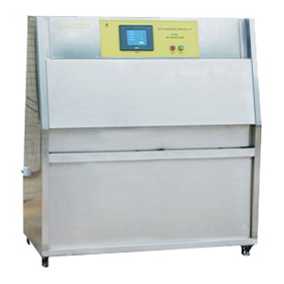How does the UV aging test machine simulate humidity

The UV aging tester reproduces the damage produced by sunlight, rain and dew. The equipment performs the test by exposing the material to be tested to a controlled interactive cycle of sunlight and moisture while raising the temperature.
The UV aging tester uses ultraviolet fluorescent lamps to simulate sunlight, while also simulating the effects of moisture through condensation or spraying. It is the testing equipment for aviation, automobile, home appliance, scientific research, etc. It is suitable for schools, factories, military, research institutes and other units.
When materials are placed outdoors, they are statistically subjected to frequent moisture effects for at least 12h per day. One of the main advantages of the UV aging chamber is that it can simulate the damage to the material in accordance with the actual outdoor humidity environment.
In such a condensation cycle, the water tank at the bottom of the chamber is heated to produce steam. Because most of this moisture is in the form of condensation, the aging chamber uses a special condensation principle to mimic outdoor moisture in accelerated artificial climate aging tests.
The cooling effect of the indoor air causes the temperature of the tested test surface to decrease by a few degrees compared to the steam temperature. This temperature difference of a few degrees allows the water to continuously descend to the tested surface during the condensation cycle. Hot steam keeps the environment of the test chamber at high temperatures with relative humidity. Test aging chamber design, to make the test plate actually constitute the side walls of the test chamber. This way the back of the test plate is exposed to room temperature room air.

Because materials are generally exposed to moisture outdoors for a long time, a typical circulating condensation system should have a test time of less than 4h. The condensate so produced is stable and pure distilled water. This water can improve the reproducibility of experimental results, eliminate the problem of water sediment contamination and simplify the installation and operation of test equipment.
Longer, heated condensation cycles are more effective than other methods such as water spray, impregnation and other high humidity environments in reproducing the phenomenon of moisture damage to materials. By conducting the aging chamber condensation process under heated conditions, the rate of moisture damage to materials is greatly accelerated.
UV Aging Chambers Simulate Humidity
The vast majority of outdoor humidity is caused by dew, not rain. Therefore, UV uses a unique condensation mechanism to simulate outdoor humidity. In UV's condensation cycle, water in the reservoir at the bottom of the test chamber is heated to produce hot vapor that fills the chamber, maintaining the relative humidity in the chamber at 100% and maintaining a relatively high temperature.
The design of the UV ensures that the sample being tested actually forms the side wall of the test chamber so that the back of the sample is exposed to the ambient room air. The room air behind the sample (outside) has a cooling effect, causing the surface temperature of the specimen to drop to a level several degrees below the vapor temperature. This temperature difference results in the presence of liquid water generated by condensation on the surface of the specimen throughout the condensation cycle. Since outdoor exposure to moisture can grow to more than ten hours per day, the UV condensation cycle typically lasts several hours. All UV models are equipped with this condensation system.
For some applications, water spray can better simulate the end-use environmental conditions. The UV/spray models are equipped with a condensation and water spray system. The shower system has 12 nozzles, 6 on each side of the test chamber. The water spray system can be operated for a few minutes and then shut down. This short period of water spraying allows for rapid cooling of the sample and creates heat shock conditions. Alternatively, the water jets can be run for several hours to create a mechanical erosion effect by mimicking the scouring action of rain. This has been found to be particularly useful for wood coatings.
2021-11-02 11:26

